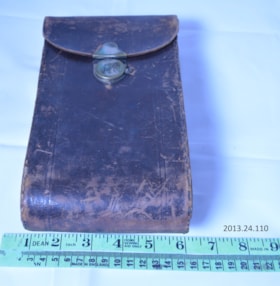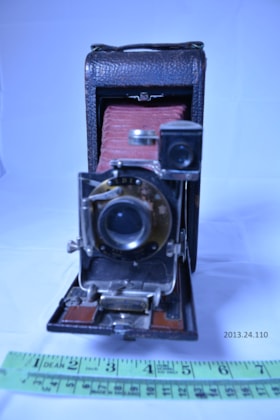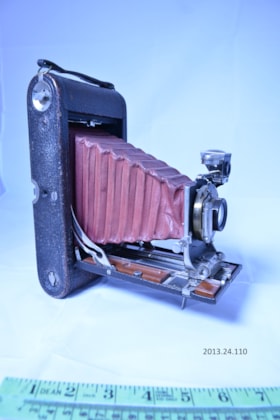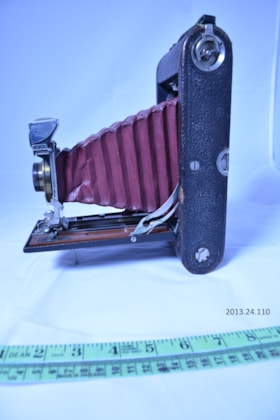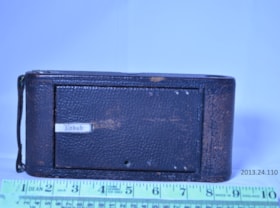Skip header and navigation
Camera
- Description
- Camera is enclosed in a black rectangular box case. The case has a slight brownish-red tinge to it. The camera has red bellows. The case has a handle on the top. The back opens. The camera has a small folding "foot" that allows it to balance when the bellows are extended.
- Title
- Kodak 3A Folding Pocket
- Manufacturer
- Kodak
- Category
- TOOLS AND EQUIPMENT FOR COMMUNICATION
- Sub-Category
- PHOTOGRAPHIC TOOLS AND EQUIPMENT
- Start Date
- 1903
- End Date
- 1915
- Description
- Camera is enclosed in a black rectangular box case. The case has a slight brownish-red tinge to it. The camera has red bellows. The case has a handle on the top. The back opens. The camera has a small folding "foot" that allows it to balance when the bellows are extended.
- History Of Use
- Eastman Kodak's first postcard format camera, the 3A Folding Pocket Kodak, was introduced in 1903 and sold until 1915. Kodak produced seven models of the 3A Folding Pocket Kodak (thankfully abbreviated as 3A FPK). The models were known as B, B-2, B-3, B-4, B-5, C and G.
The FPK Automatic shutter was equipped with a pneumatic release. The shutter had one instantaneous speed plus time and bulb. The pneumatic release could prevent camera shake when used with the time and bulb settings. The rubber hose and bulb were removable, but because of their size, they could also be left permanently attached, as they did not interfere with closing the camera.
The 3A FPK created 3 1/4 x 5 1/2 inch postcard format images on Kodak 122 roll film. Kodak 122 film was first introduced for use in the 3A FPK and was available in four, six or ten exposure lengths.
A glass plate adapter with ground glass focusing screen was available as an extra cost accessory, and allowed photographs to be taken on glass plates. Eastman Kodak called this accessory the Combination Back. The catalog price of the back is three dollars and fifty cents. Double plate holders were priced at $1 each.
- Accession No.
- 2013.24.110
- Type of Record
- Museum Artifact
Less detail
